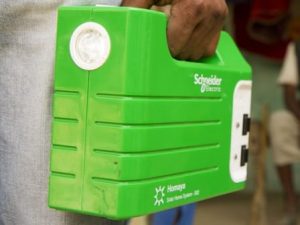Schneider Electric is a France based global specialist in energy management and automation. Now the company present Homaya Solar Home Systems, portable electrification solutions designed to improve lives in off-grid households in Africa and Asia. These complete solutions comprise solar panels, an in-built battery and 3-4 lamps. In addition to powering the lamps, the battery can be used for direct-current (DC) electrical devices such as radios, fans and televisions. This robust system offers access to sustainable energy for African and Asian homes for an up-front investment of around US$100.

Homaya Solar Home Systems are portable electrification solutions designed for off-grid households in Africa and Asia. Source: Schneider Electric
Gilles Vermot Desroches, Senior Vice President Sustainability at Schneider Electric commented: “Schneider Electric’s mission is to offer all its clients solutions that are safe, reliable, efficient and sustainable. For populations living with less than 1€ per day in remote areas of Africa and Asia, who are not yet connected to the grid, new solutions like Homaya are required. These products need to withstand certain conditions such as extreme heat or humidity, while also being affordable. Through its Access to Energy program, Schneider Electric is innovating in product design and business models, seeking new forms of distribution and financing for clients to acquire or rent products and new ways of providing it to end-users”.
Schneider Electric has long made sustainability objectives a strategic priority. Its Access to Energy program aims to offer access to sustainable energy to people in remote areas. Homaya was designed to meet three key specifications: robustness, quality and affordability. The reliable Lithium Ferro Phosphate battery, which has a five-year lifespan, comes with two lamps with five-meter long cables, enabling them to be positioned around the home. The battery can also charge 1-2 portable lamps while its three USB ports can charge devices such as mobile phones. It is also possible to add a second solar panel to accelerate the battery charging.
Product distribution is challenging, especially due to the remote location of those homes. Schneider Electric teams are already building on their experience in launching products and solutions for people in remote areas, setting up partnerships with distributors and microcredit organizations.
Credit featured image: Cécile Geng

















